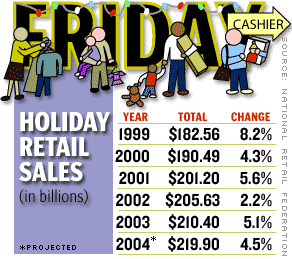
NEW YORK (CNN/Money) -
The countdown to Black Friday has begun and there's no doubt that retailers are anxiously anticipating one of the biggest shopping days of the year.
Wal-Mart, however, is playing it cool.
In fact, the world's largest retailer won't even release sales numbers for the day after Thanksgiving, dubbed 'Black Friday' because it's when retailers are said to finally move out of the red (representing losses) and into the black (profits).
"We're not doing it this year because more than ever our customers are doing their holiday shopping closer and closer to Christmas," Wal-Mart spokeswoman Sharon Webber told CNN/Money. "One sales day is not an indicator for the entire holiday period."
Wal-Mart's decision has some industry watchers scratching their heads.
For one thing, Black Friday was the biggest sales day of 2003, topping even Christmas Eve, which has long been No. 1, according to Michael Niemira, chief economist and director of research with the International Council of Shopping Centers (ICSC).
"Part of the reason was that retailers built sales momentum by offering deep discounts leading up to Black Friday," said Niemira.
More grey than black?
The NRF, the industry's largest trade group, expects total sales for the November-December shopping period to grow 4.5 percent to $219.9 billion, softer than last year's increase of 5.1 percent.
When it's all over, retailers may have to settle for a good rather than a spectacular holiday. The consensus among analysts is that total spending for the two months will grow about 4 percent.
"Retailers have to be aggressive in the coming weeks. Those with attractive discounts will do well," said George Whalin, an independent retail consultant.
Chain stores such as J.C. Penney, Sears, Kohl's and Nordstrom are already laying their deep discount cards on the table, offering as much as 50 percent off storewide merchandise as early as mid-November.
Said Niemira, "The promotional activity is better than last year. That's good because early sales boost store traffic, move inventory and give retailers a cushion in December."
Last year, shoppers missed out on the big bargains and bought seasonal merchandise that was near full price because stores kept a tight rein on inventories heading into the fourth quarter.
The good news for shoppers is that price cuts could keep coming.
"Retailers have planned their inventories very well again this year but there's no point in that if you get can't shoppers into your store," said Howard Davidowitz, chairman of Davidowitz & Associates. "Expect substantial deals as we go along, especially in clothing and consumer electronics."
Energy versus enthusiasm
Delos Smith, an economist with New York-based business research group Conference Board, says he's keeping a close eye on surges in energy prices, which could pressure consumer spending.
"Last year the consumer was troubled by slow economic growth and a tight labor market. Those concerns have been replaced by energy," Smith said.
Consumer sentiment numbers in recent months indicate consumer spending is being weighed down by higher prices at the pump and concern over spikes in home heating bills, particularly in the event of a very long and cold winter.
Said Smith, "The key to a successful holiday for the industry is not how many presents the kids get. It's about Uncle Charlie and Aunt Millie. Will they get a gift or not? If the energy costs are high, the secondary players get scratched off the list. It's the difference between buying a card or a gift that could determine the final outcome."

|

